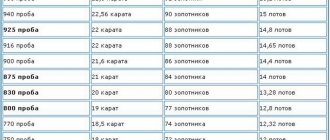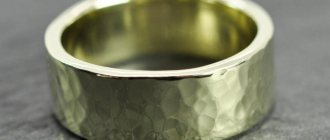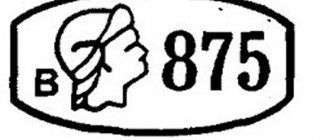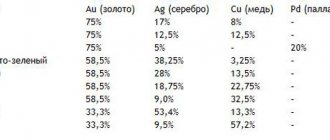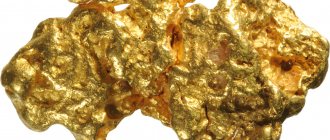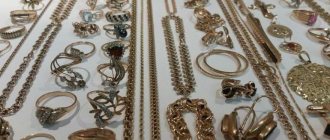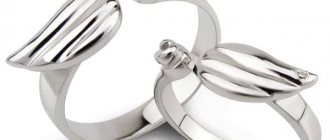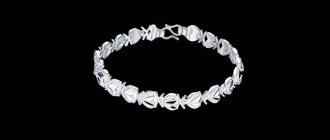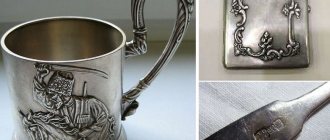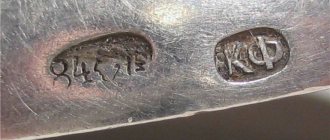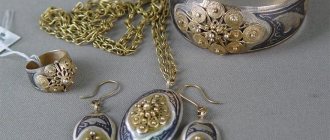The 325 alloy is currently considered low-grade gold. Since it turns out that its weight in the product is only 32.5 percent, and the rest is silver, copper, palladium. That is, the main part of the product is an alloy, not a noble metal. In the table below we will present to you the general classification of gold samples and its relationship to carats, and the spool system.
| Gold samples | Carat system | Spool system |
| 990 and above | 24 K | 96 |
| 958 | 23 K | 92 |
| 916; 917 | 22 K | 88 |
| 875 | 21 K | 84 |
| 833 | 20 K | 81 |
| 800 | 19.2 K | 76.8 |
| 792 | 19 K | 76 |
| 750 | 18 K | 72 |
| 625 | 15 K | 60 |
| 585; 583 | 14 K | 56 |
| 500 | 12 K | 48 |
| 417 | 10 K | 40 |
| 375 | 9 K | 36 |
| 333 | 8 K | 32 |
As we can see from the table, 325 gold is not even mentioned here.
Composition of gold alloys
In addition to gold, jewelry alloys contain a ligature, which can consist of:
- platinum (increases elasticity, discolors gold, increases melting point);
- silver (increases ductility, makes the alloy more malleable and easier to process, gives a white tint);
- palladium (brightens, imparts plasticity, increases the melting point);
- nickel (gives hardness, “whitens”, increases resistance to corrosion, but can cause an allergic reaction);
- cadmium (thanks to it, the alloy melts easier, it also gives a greenish tint);
- copper (increases hardness, gives a reddish tint, reduces anti-corrosion properties);
- zinc (improves the fluidity of the metal, reduces the melting point, can give a greenish tint).
These additives increase the consumer properties of the alloy - making it stronger, more durable, and resistant to wear. The hallmark designation in numbers is applied to each piece of jewelry, as required by the legislation of the Russian Federation (all products made from alloys containing more than 30% precious metal must be stamped).
Detailed description of the study
A method for examining three different portions of urine obtained during one urination, which is used to clarify the location of lesions in the genitourinary system.
The urinary system includes the kidneys, ureters, bladder and urethra (urethra). Urine formation occurs in the kidneys. The ureters drain urine into the bladder, which serves as a reservoir. Emptying the bladder occurs through the urethra. Pathologies of the urinary system can occur at each level, causing various diseases. For effective treatment, the doctor needs to know which part of the genitourinary tract is affected.
For this, a three-glass sample is used, during which three portions of urine are obtained, each of which will be examined separately. The results of the analysis allow us to draw a conclusion about the affected part of the urinary tract and determine the location of the damage.
Who tests?
In Russia, the gold marking process is regulated by the State Assay Office under the Ministry of Finance. It is this state assay supervision body that carries out analysis, testing, and hallmarking of gold products.
A hallmark on a piece of jewelry is a guarantee that it is truly made from the appropriate precious alloy. If the sample is missing, looks fuzzy or suspicious, then you may have a fake. You can check the sample of the product at the assay office.
Where is gold usually sampled? Most often - on the inner surface of a ring, on a link in earrings, on a link near a lock in chains and bracelets. To preserve the aesthetic appearance of the decoration, the markings are made miniature.
Stamps on products before 1927
In 1899, a new mark for products made of precious metals appeared in Russia in the form of a profile of a woman’s head turned to the left. Next to the stamp, letters were required to indicate the initials of the corresponding assay district, as well as the value of the spool assay in Arabic numerals.
However, already in 1908, after the First Russian Revolution, further changes appeared in the appearance of the mark. First of all, this was caused by the need to gradually switch to international standards. True, in 1908, all the changes boiled down to the fact that the female profile on the brand turned to the right. The sampling system remained spool-type.
Sample systems: metric, carat, spool
The numerical designation of the sample is applied to all jewelry, but not all jewelry is marked according to a single system. Today, two sample systems are used - metric and carat, but in the last century in Russia the spool system was used.
Metric
Used in most countries of the world. The highest standard of the system is 1000th. For example, a 750 gold alloy contains 75% gold, the remaining 25% comes from other metals.
It is difficult to achieve the exact content of precious metal in an alloy, so GOST sets a remedium of 3 units for alloys containing gold, silver, and copper. That is, a gold alloy of 375 purity of gold should contain from 372 to 378 units (a deviation of 3 units in both directions is allowed). If the material contains nickel, then the remedium is 5 units. For an alloy of 585 standard, only a positive remedium of 5 units applies - deviations are allowed upward, but not downward.
Carat
Currently used in some European countries and the USA. The highest standard of the system is 24. Samples of 9, 14, 18, 22 are used - they show the content of pure precious metal in the composition. For example, 18 karat gold means that 18 of 24 parts are pure gold (this corresponds to 750 fine gold in the metric system). 1 carat in this system is equal to 9.744 grams.
Zolotnikovaya
Spool samples are old gold samples; they are no longer used. This system was used in Russia until 1927. The highest standard is 96. The units of measurement are:
- 1 pood = 40 pounds = 16.380 kilograms.
- 1 pound = 96 spools = 409.512 grams.
- 1 spool = 4.266 grams = 96 shares.
- 1 share = 0.044 grams.
For marking jewelry, samples of 56, 72, 92, 94 were used. If a sample of 56 was indicated, this meant that 1 pound (96 spools) of such an alloy contained 56 spools of pure gold (this corresponds to 585 samples of the metric system).
Branding methods
Previously, jewelry was marked with a convex test. Later, its appearance was changed, as was the method of application. Technologies used today:
- impact method: was popular earlier, based on mechanical impact on metal with a self-made impact stamp;
- electroerosion (electric spark method): this option has many advantages, they note that there is no risk of severe deformation of the metal, creating zones of concentration of internal stress, as a result, they receive a mark with a depth of 0.1 to 1 mm, and the best characteristics are distinguished by a test made on a hot, colored metal, as well as when applied using a press;
- laser engraving: the technology ensures high precision of execution, which allows it to be used for making micro-stamps, the laser beam is considered the thinnest tool, it is used to make signs up to 1 mm in size, this is the method that has become widespread today, in addition, there is another factor that indicates about the wide capabilities of the laser - non-contact implementation.
Jewelry mark
What types of gold exist?
You can find out what standard of gold the jewelry is made from by the markings that must be applied to each product. In jewelry, the following gold samples are used: 375, 583, 585, 750, 958. In some countries, another standard is used to create jewelry - 333 (such an alloy quickly oxidizes). This is not an exhaustive list - GOST 6835-85 mentions 18 different samples and 40 gold alloys.
Sample 375
Composition: 37.5% gold, 62.5% silver and copper.
- Used for making chains, earrings, bracelets, pendants, wedding rings.
- Due to its low price and durability, it was widely used in the Soviet Union for the manufacture of “gold” wristwatches and wedding rings.
Depending on the percentage of copper and silver, the alloy can range in color from yellow to deep red (more copper means more red). Sometimes palladium is added to the composition (with 40% palladium and 10% silver, a very delicate creamy shade is obtained). The material is durable, strong, but is susceptible to oxidation, which is why it loses its attractiveness and becomes grayish when polishing is lost. Jewelers jokingly call this sample “an alloy of copper and silver containing gold.”
Sample 583
This alloy was the gold standard of the USSR. Most of the jewelry at that time was made from this material (almost every family preserved rings or earrings of 583 standard, which were once worn by mother or grandmother). In 2000, 585 sample became the standard in Russia.
Sample 585
- Used to make wedding rings, earrings, crosses, tie clips, and church utensils.
- The alloy is durable and easy to process; various technologies can be used with it - laser welding, weaving, blowing.
Composition option 1: 58.5% gold, 33.5% copper, 8% silver.
A durable alloy with a reddish or yellow tint, easy to solder. The metal is malleable and does not tarnish in air.
Composition option 2: 58.5% gold, 41.5% nickel and palladium.
Durable alloy with a white tint, easy to solder, does not oxidize.
Sample 750
Composition option 1: 75% gold, 25% silver.
Material with this composition has a greenish tint.
Composition option 2: 75% gold, 21% copper, 4% nickel.
Reddish alloy.
Composition option 3: 75% gold, 15% silver, 10% copper.
Yellow alloy.
All three versions of the 750-grade material have excellent characteristics: they are durable, wear-resistant, and easy to solder, cast, and polish. They tolerate contact with the environment normally, but due to their increased softness they require careful and careful handling. The alloy of this sample is most often used to create frames for fragile precious stones, in the manufacture of products with filigree, as a basis for applying enamels (to prevent the enamel from tarnishing, choose a composition with a copper content of up to 16%).
Sample 958
Composition: 95.8% gold, 4.2% silver and copper.
The metal is bright yellow, malleable and soft, and was formerly used to make wedding rings. Today, domestic jewelers almost never use this high-grade alloy in their work, but products made from it are often found in Arab countries. Due to its softness, such an alloy is prone to deformation; polishing on jewelry made from it does not last long.
Sample 999
Almost pure noble metal with a negligible amount of impurities. Bank bars are made from this gold. It is not used to create jewelry due to its tendency to deform.
Recommendations for care, cleaning and storage
Although 325 is not sterling silver, the original copper works are also very interesting.
Caring for copper jewelry has its own characteristics:
- darkening (oxidation) is caused by acid. The network suggests cleaning the surface with vinegar, ascorbic or citric acid (a slice of lemon will do). The raid will come back very quickly;
- Jewelry wipes for gold and silver are not suitable for prevention.
Leuchtturm (Germany) is on sale, but you need to purchase it “for copper coins and alloys.”
At home, copper rings and other decorations are cleaned with raw potatoes.
Stored in jewelry boxes.
Please note: jewelers do not recommend storing costume jewelry together with jewelry.
Price per gram of gold of different samples
Of course, the higher the content of noble metal in the alloy, the higher its price. The cost of materials of different samples depends on the current price of gold; the cost of finished products is also affected by the manufacturer’s and seller’s markups.
For example, today the Central Bank of the Russian Federation has set a price of 2,740 rubles for 1 gram of gold. To find out the cost of a precious alloy of different samples, you need to multiply this price by the appropriate coefficient:
- for sample 375: 2740*0.375=1027.5 rubles per 1 gram;
- for sample 585: 2740*0.585=1602.9 rubles per 1 gram.
The price of 1 gram of jewelry will be higher, because gold has a long way to go before it appears on the display in the form of a ring or bracelet. The cost of the finished product includes the work of jewelers, the cost of paying workers, losses on rejection, associated costs of the jewelry enterprise, and the store’s markup.
Where can you buy or sell
The main sources of such purchases:
- from hands (gypsies, internet, advertisements);
- oriental markets in hot countries, where any sample will be supplied at the request of the buyer.
In a pawn shop, the risk of buying such a “masterpiece” is minimal; it is a fake (version 6). They will also not accept the sale/deposit: the simplest rapid test will bring the villain to light.
How much does 1 gram of silver of this standard cost today?
If you take the price of silver today on the currency section of the Moscow Exchange, for example, you can determine the cost of the 325th sample.
| Price 999 standard according to the Central Bank | Market value of the sample today | Scrap price | Price in jewelry |
How to determine gold purity by the color of the alloy
The color of pure gold is bright yellow, but due to its softness, this metal in its pure form is not used to create jewelry. Jewelry is made from gold alloys, in which only part of the composition is allocated to gold. Ligatures (additives) make the connection harder, stronger, and give it different shades.
Based on the shade of the alloy from which the product is made, one can assume its sample. But this method of determining the composition is imperfect; only examination can accurately determine the percentage of gold and other metals.
Pink
This shade is characteristic of alloys containing silver and copper, in particular the following samples:
- 375: dark pink,
- 585: soft pink;
- 750: slightly pinkish.
White
If you see a piece of jewelry with a white tint, most likely it is 750-grade metal. 25% of the composition is occupied by silver and palladium or silver and nickel.
Green
- Dark green color is typical for 750 standard with the following composition: 75% gold, 15% silver, 6% copper, 4% cadmium.
- The pale green material is obtained when 23% copper and 2% cadmium are added to 75% gold.
- The yellow-green metal is most likely 750 fine, and 25% of the composition is silver.
Violet
Gold jewelry may have a purple tint if it is made from a 14-karat alloy that contains 25% aluminum or potassium. If the color is rather bluish, then with a high probability it is a composition of 46% noble metal and 54% rhodium, cobalt or indium.
Reviews
I couldn't see the sample when I bought it. I found a piece of jewelry that I liked at a pawn shop. Of course, the ring is used, but from the outside I wouldn’t say that anyone was wearing it. They offered me a magnifying glass, the only way I was convinced that it was really 585 gold and not a fake with a letter designation.
Valentina P., Donetsk
Alisa T. g, Ivanovo
Somehow I fell for a fraudulent scheme: I bought a ring in the jewelry department, I didn’t study the mark, I just noticed that it was there. But she noted to herself that in the center of sample 585 there was some kind of low eight. When the ring turned black, I realized that I had been deceived, but it was too late to look for the scammers, they disappeared. I examined the sample, and it said 5S5.
I thought I had already seen everything, but I didn’t expect to see a sample of 5S5 in a fairly large store. They explained something to me about the methods of applying the sample, but the ring was then removed from the counter. Of course, I didn’t believe it, which was confirmed when the product disappeared from sale.
Vasily P, Voronezh
